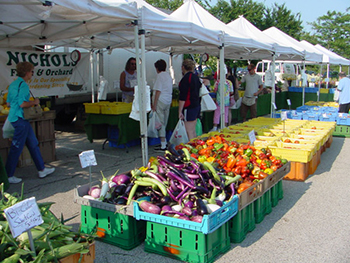Food Policy Strategy Paper
Food Systems Strategy Summary
Table of Contents
- Acknowledgments
- Executive Summary
- Issues, Challenges, Opportunities
- A New Vision for Food Systems
- Recommendations
- Appendices
- Endnotes

The Chicago area has a long history as a focal point for the production, processing, trading, and consumption of food, and is home to hundreds of communities with diverse food cultures supporting vibrant food markets and restaurants. Although an agricultural powerhouse, most of what Illinois grows doesn't directly feed humans, partly as a result of federal policies that subsidized high-volume crops like grains but not "specialty" crops like fruits and vegetables.
While a shift away from local food production to a global system has taken root slowly over the course of the past century, in recent years the number of farms growing produce directly for human consumption grew in all but one county in the Chicago region.
Over the coming decades, population growth, climate change, development pressures, global trends, economic realities and concerns about the environment, equity, and food safety will all have an impact on Illinois' ability to continue to meet its own food needs and send farm products to the rest of the world. This strategy paper evaluates existing conditions and challenges, and provides recommendations on how the region can achieve a sustainable food system by 2040.
A sample of findings:
Evolution of the Food Production System:
The shift away from local food production to a global system has taken root slowly over the course of the past century, aided by government policies and technology investment designed to build economies of scale and efficiency in agriculture. Now, fewer farms produce greater amounts of food: while the number of farms declined from 6.8 million in 1935 to 2.10 million in 2005, U.S. farm output in 2006 was 152 percent above its level in 1948.
What Do Our Farms Grow?
Most of what Illinois grows doesn't directly feed humans, partly as a result of federal policies that subsidized high-volume crops like grains but not "specialty" crops like fruits and vegetables. Corn, soybeans and forage crops like alfalfa constitute the bulk of crops grown in the region. Only a tiny amount (0.007 percent) of cropland was harvested for vegetables in 2007.
An Increase in the Number of Small Farmers and Organic Farming:
Between 2002 and 2007, the number of farms growing produce directly for human consumption grew in all but one county in the region. For the first time in a long time, the number of small farmers increased in 2007, regionally, nationally and statewide, with more diversity of both crops and farmers. And the number of certified-organic farms in the region increased six-fold in recent years, from 7 to 45.
If you're interested in learning more about food systems, please review the following CMAP strategy report. Comments and criticism are encouraged.
|
Links |